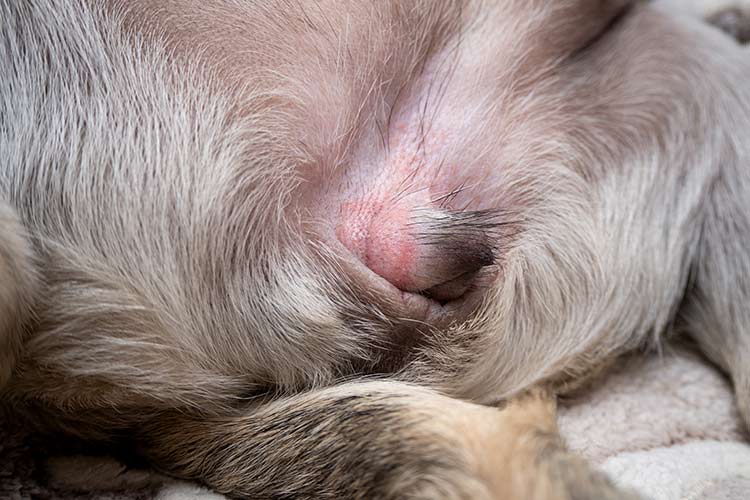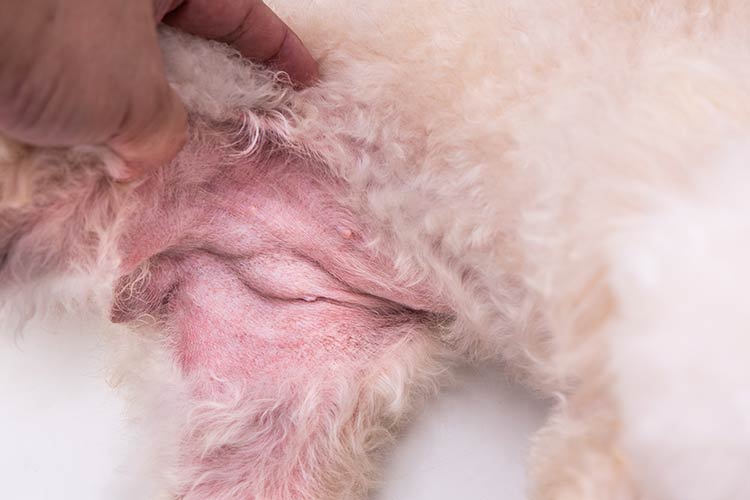
“Doc, Sadie has a really bad odor…” When he called to schedule an exam, a client explained about his dog over the phone. I asked him some basic questions about her diet and bathroom habits and set up a visit. Before the exam, I reviewed her file and saw she was still intact. As I started my exam, I told Sadie’s owner that there were a handful of possible causes for the pungent fish-like aroma.
In this article, we’ll go over the reasons for bad odor in female dogs and what you can do when you first notice the stench. I’ll describe early symptoms that suggest a problem and when you should head to the vet. So you know what to expect, I’ll go over possible treatments and how much they usually cost.
Overview of bad odor in female dogs (fishy or yeasty)
You can expect certain odors in dogs, like that wet dog smell after swimming or bathing. But other aromas are not normal. If your pooch starts smelling bad, for example: fishy or yeasty, it usually points to an underlying condition.
While certain odors like anal gland smells or ear infections can emanate from either gender, certain scents are unique to female dogs, particularly from a vaginal or uterine infection. If your dog starts to stink, look for other symptoms that can help you figure out the cause of the problem.
Top reasons for bad odor in female dogs
When your female dog starts to stink, there are various potential causes.
1. Urinary tract infection
A dog’s urine normally smells like pee. If it starts to have a fishy or yeasty odor, it probably indicates a urinary tract infection(UTI). UTIs occur when bacteria or yeast enter the bladder and begin to grow. Signs of an infection include:
- Strong fishy or yeasty odor
- Frequent attempts to urinate
- Pain or whining during urination
- Licking the genital area
- Increased drinking/thirst
- Blood in the urine
- Accidents in the house
Any time that your dog’s urine starts to stink, contact your veterinarian. They can take a urine sample for analysis and prescribe appropriate antibiotics. Most of the time, dogs respond well and have a good prognosis with treatment. If a UTI is left untreated, the infection can spread to the kidneys.
2. Vaginal infection

Swollen dog vulva with reddened skin
Like the skin and gastrointestinal tract, some bacteria normally reside in the vagina. However, if the microorganisms overgrow and cause an infection, there will be a foul, fishy odor. Signs of vaginal infection in dogs include:
- Fishy odor coming from the vagina
- Licking the vaginal area
- Reddening/swelling around the vagina
- Peeing a lot
- Scooting
- Vaginal discharge with pus or mucus
Any age of intact or spayed females can develop a vaginal infection. Following an examination and diagnostic tests, the treatment involves antibiotics and vaginal cleansing douches. Spaying can help to reduce or prevent recurrences. Most dogs respond to treatment in 2-3 weeks, but the prognosis depends on the severity of the infection.
3. Pyometra
Intact bitches can develop a uterine infection which is a life-threatening condition. Pyometra, or pus in the uterus, can affect any age, but it is more common in older females. If your dog develops pyometra, you may notice:
- Increased thirst
- Increased urine production
- Pus discharge from the vulva
- Vomiting or diarrhea
- Anorexia
- Depression and lethargy
- Fever
- Distended abdomen
- Panting
Pyometra is an emergency requiring immediate veterinary care. The treatment of choice is spaying. If the condition is caught and treated early, the prognosis is fair. Unfortunately, dogs are often quite ill by the time pyometra is diagnosed. In this case, surgery is more challenging, and recovery takes longer.
Click here to view a picture showing surgical removal of a pus-filled uterus to treat pyometra in a dog (WARNING: Graphic image).
Dogs generally receive IV fluids during and after surgery. Follow-up care includes 2 weeks of antibiotics.
4. Anal gland disease
If your dog has issues with her anal glands, you’re likely to notice a fishy odor. Whether your pooch has an impaction, infected, or abscessed sacs, she may show the following signs:
- Scooting
- Excessively licking or biting the anus
- Straining or pain while pooping
- Turning and looking at the anus
- A fishy odor
- Brown spotting on bedding
- A brownish or pus discharge on poop or around the anus
Dogs with anal gland issues should be examined by a veterinarian. Treatment includes manual expression of impacted glands, lancing/draining infected glands or abscesses, and antibiotics to treat infections. If an impaction or infection is severe enough, your vet may surgically remove the sacs.
While you’re waiting for your appointment, you can apply a warm compress to your dog’s butt to help reduce inflammation. The prognosis is good with appropriate treatment.
5. Yeast infection
Dogs normally have yeast living on their skin, but sometimes, it multiplies and causes an infection of the paws, abdomen, ears, and genitals. Signs of a yeast infection include:
- Loss of hair
- Excessive grooming
- A yeasty odor
- Red, inflamed skin

Depending on the location of your dog’s yeast infection, your veterinarian will treat it with antifungal ointment, cream, or oral medication. The prognosis for recovery is good. Learn more about vaginal yeast infections in dogs.
What to do when your female dog smells bad
If your female dog develops an unusual odor that’s fishy or putrid,
- Contact your veterinarian and schedule an examination
- Observe your dog for signs to help you know what’s causing the odor
- Prevent your dog from licking or chewing at the anus or genitalia – use an e-collar if needed
- Gently clean discharge from your dog and provide clean bedding
Early symptoms of bad odor in female dogs
Understanding the early signs of conditions causing bad odor in female dogs can help you get prompt treatment for your furbaby.
- A putrid or fishy odor that won’t go away after bathing your dog
- Frequent licking or grooming of the hind end
- Discharge from around the anus or vulva
- Scooting
- Straining to pee or poop
- Inflammation of the skin, anus, or vulva
When should I visit the vet?
When your dog has a sudden change in body odor, or the smell is fishy or unusual, you should schedule a visit to the vet. Head straight to the emergency clinic if you observe:
- Lethargy and depression
- Loss of appetite
- Vomiting or diarrhea
- Distended abdomen
- Collapse
- Fever
Treatment options and likely costs
Treatments vary depending on the cause of your female dog’s bad odor.
Urinary tract infection
For a urinary tract infection, the cost of an office visit is about $75-150. Diagnostic tests like bloodwork and a urinalysis may cost an additional $70-200 or more.
Once your vet has a diagnosis, a 2-week course of antibiotics runs around $20-50. If your dog requires anti-inflammatories or pain medications, expect another $5-20 for oral options and more for injections.
Vaginal infection
The costs of an office visit and diagnostic work for a vaginal infection will be similar to that for a UTI. Medications to treat the condition may cost up to about $200 depending on your dog’s size and the extent of the infection. If your veterinarian recommends spaying your furbaby, the cost of surgery including screening bloodwork, anesthesia, and supportive measures is approximately $400-600.
Pyometra
Depending on your dog’s age, breed, and severity of infection, the treatment for pyometra can cost about $1000-1500 or more. This includes pre-surgical workup, supportive fluids, and post-operative care.
Anal gland disease
Treatment for anal gland issues varies depending on the underlying condition.
- Manual expression of the anal glands usually runs around $50
- Flushing infected anal glands with antibiotics costs about $100 or more if your dog requires sedation
- Surgical removal of chronically/severely impacted or infected glands is tricky and requires a veterinary surgical specialist. The cost is generally around $750-2500.
Yeast infection
The cost to diagnose a yeast infection in your dog will run about $75-150. Treatment for this condition usually takes several weeks, and the cost varies widely depending on the location and severity of the infection.
Frequently asked questions
How often should I clean my female dog?
Cleaning your female dog’s private area can help reduce the likelihood of infection and unwanted odors. If your furbaby is intact, she may groom herself during her heat cycle, but if she doesn’t, you can clean any discharge from her once every day. When she’s not in heat, cleaning the private area a few times a week is sufficient.
Can a female dog’s odor be seasonal?
Intact female dogs usually go into heat 1-2 times per year. During this time, hormonal changes can cause certain odors that attract male dogs. The smells are usually not detectable to humans, but some owners claim they notice a unique aroma.
Can spaying a female dog help with the odor?
Spaying a female dog can help reduce the risk of developing a strong odor in some cases but not others. Because spayed females have their uterus and ovaries removed, they cannot develop pyometra. However, there is evidence that spayed females are more likely to suffer from vaginal and urinary tract infections. Consult with your veterinarian about the best option for your dog.
Can bad odor in a female dog indicate a serious health issue?
Our furbabies usually don’t stink that much. So, when you notice your female dog has a bad odor, it’s a cause for concern. The smell may indicate an infection or another disease. If your girl develops an unusual stench, try to pinpoint the source and call your veterinarian.
Disclaimer: This website's content is not a substitute for veterinary care. Always consult with your veterinarian for healthcare decisions. Read More.


My female has always had a clear leakage maybe once every two to three weeks has very bad smell I have. Ever smell before she is 2 1/2 years old fixed when she does it she jumps up like what happen never licks drags or acts funny very healthy and always done this what is wrong could it be dietall she eats is lunch meat and dogs snacks and dog bones
I’m sorry to hear about this foul-smelling discharge and understand your concern. As she is neutered, this should not be a sign of a uterus infection. However, we’d have to consider e.g. vaginitis, a urinary infection, anal gland disease, a foreign body within the vulva etc.
The first step is a vet check so she can be examined. This should include a rectal and vaginal exam, and a swab of any discharge may be taken. They vet can assess the anal glands to see if they need emptying, and analyse her urine to check for an infection.
It may be that she needs e.g. some antibiotics or anti inflammatories.
I’d not expect this to be diet related, unless you are seeing other signs such as diarrhoea, bloating or flatulence.
“The information on this website is not a substitute for in-person veterinary care. Always seek advice from your veterinarian if you have concerns about your pet’s medical condition.”